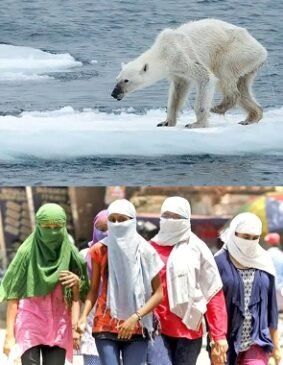Lucknow: The situation of heatwave in the state did not diminish and on Sunday, the temperature reached 46 degrees Celsius in several cities. The Meteorological Department has predicted no relief from the heat in the next two days (17-18 June 2024). Lucknow reached 45.6 degrees Celsius, the highest June temperature in the city in the past eight years. Similarly, Prayagraj recorded 47 degrees Celsius, the hottest day of the year in the city.

Environmental Scientist and Director General (Technical),
School of Management Sciences, Lucknow.
Approximately 65% of the glaciers in the Arctic have already melted, leaving only 35% remaining, significantly reducing the area capable of reflecting solar rays back. Consequently, while ice continues to melt, sea levels rise and evaporated water droplets, combined with greenhouse gases, accumulate at high atmospheric levels, hindering temperature regulation (radiation). This increase in heat worsens each year, presenting a dangerous picture of environmental degradation.

Esteemed environmental scientist and Technical Director of the School of Management Sciences, Dr. Bharat Raj Singh, also elucidates that this is an annual event occurring approximately every nine days due to the closest proximity between Earth and the Sun. As a result, increased solar radiation produces an imbalance in the Arctic’s ice properties, which act as a natural shield against incoming solar radiation. However, with melting ice cover, this protective mechanism is compromised, contributing to unchecked solar heat that increases Earth’s temperature.
Moreover, due to warmer sea temperatures and delayed cooling at night, the Earth’s average temperature continues to rise through the normal process of land cooling during the night. As ice melts into the sea, the surface area of water expands, which fails to cool down despite continuous exposure to solar rays.
Dr. Bharat Raj Singh highlights a third significant factor: the expansion of greenhouse gas emissions from industrial activities, especially from the reduction in forests that previously acted as natural carbon sinks. These emitted gases, combined with evaporated water droplets, create a haze in the atmosphere, impeding the dissipation of solar heat (radiation) onto Earth and contributing to the continuous increase in global warming.

With the rapid acceleration of evaporation rates on the ocean’s surface and the mixing of water vapor with greenhouse gases at altitudes of 14-15 kilometers, Dr. Bharat Raj Singh also warns of catastrophic events in the future. The consequences are evident worldwide, from irregular weather patterns to destructive events like cloud bursts, observed in countries such as America, Italy, Germany, France, Arab countries, China, Australia, and others.
 Prof. Singh emphasizes that global warming and climate change are rapidly melting Arctic ice. Glaciers are shrinking, and at the current rate of melting, virtually no ice will remain in the Arctic by 2040. From April 2003 to April 2013, Arctic glaciers have been melting at a rate of ten (10) million tons per year. It is estimated that by the end of the century, sea levels could rise by 3.5 to 13 feet, increasing Earth’s mass from 1,397 billion to 1,450 billion tons. This could potentially alter Earth’s axis of rotation (23.43 degrees), slow Earth’s rotation speed, and lead to destructive consequences such as increased earthquakes, destruction of human-made structures, and so on.
Prof. Singh emphasizes that global warming and climate change are rapidly melting Arctic ice. Glaciers are shrinking, and at the current rate of melting, virtually no ice will remain in the Arctic by 2040. From April 2003 to April 2013, Arctic glaciers have been melting at a rate of ten (10) million tons per year. It is estimated that by the end of the century, sea levels could rise by 3.5 to 13 feet, increasing Earth’s mass from 1,397 billion to 1,450 billion tons. This could potentially alter Earth’s axis of rotation (23.43 degrees), slow Earth’s rotation speed, and lead to destructive consequences such as increased earthquakes, destruction of human-made structures, and so on.
He mentioned that due to the lack of financial institutions and universities to prepare his research models, his reference was made in the book. Because Earth’s volume is 12,756 kilometers, it is 40,054 kilometers. In this way, we are spinning at the speed of 1,669 kilometers per hour. From 5-6 milliseconds per second change in speed, the destructive catastrophe has become the change in the world.
Professor Singh says that now is the time to avoid the tyranny of climate change. The use of renewable energy should be increased instead of hydrocarbon-based energy systems.






